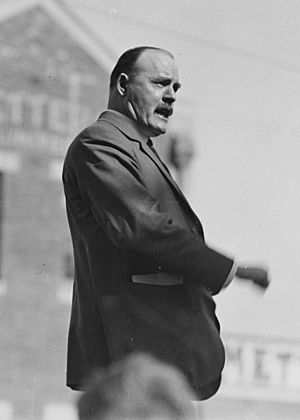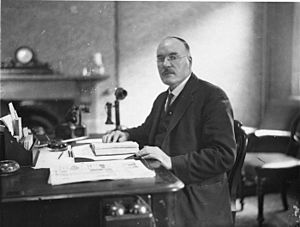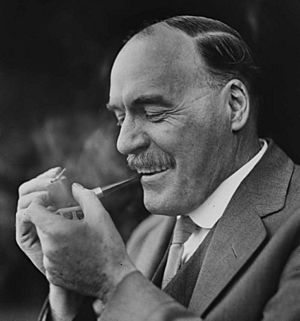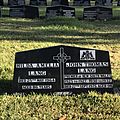Jack Lang (Australian politician) facts for kids
Quick facts for kids
Jack Lang
|
|||||||||||||||||||||||||||||||||||||||||||||||||||||||||||
|---|---|---|---|---|---|---|---|---|---|---|---|---|---|---|---|---|---|---|---|---|---|---|---|---|---|---|---|---|---|---|---|---|---|---|---|---|---|---|---|---|---|---|---|---|---|---|---|---|---|---|---|---|---|---|---|---|---|---|---|
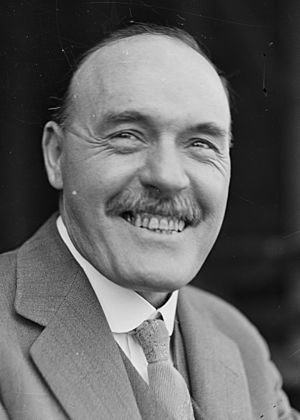
Lang, 1928.
|
|||||||||||||||||||||||||||||||||||||||||||||||||||||||||||
| 23rd Premier of New South Wales Elections: 1925, 1930 |
|||||||||||||||||||||||||||||||||||||||||||||||||||||||||||
| In office 4 November 1930 – 16 May 1932 |
|||||||||||||||||||||||||||||||||||||||||||||||||||||||||||
| Monarch | George V | ||||||||||||||||||||||||||||||||||||||||||||||||||||||||||
| Governor | Philip Game | ||||||||||||||||||||||||||||||||||||||||||||||||||||||||||
| Preceded by | Thomas Bavin | ||||||||||||||||||||||||||||||||||||||||||||||||||||||||||
| Succeeded by | Bertram Stevens | ||||||||||||||||||||||||||||||||||||||||||||||||||||||||||
| In office 17 June 1925 – 18 October 1927 |
|||||||||||||||||||||||||||||||||||||||||||||||||||||||||||
| Monarch | George V | ||||||||||||||||||||||||||||||||||||||||||||||||||||||||||
| Governor | Dudley de Chair | ||||||||||||||||||||||||||||||||||||||||||||||||||||||||||
| Preceded by | George Fuller | ||||||||||||||||||||||||||||||||||||||||||||||||||||||||||
| Succeeded by | Thomas Bavin | ||||||||||||||||||||||||||||||||||||||||||||||||||||||||||
| 11th Leader of the Opposition in New South Wales | |||||||||||||||||||||||||||||||||||||||||||||||||||||||||||
| In office 22 June 1932 – 5 September 1939 |
|||||||||||||||||||||||||||||||||||||||||||||||||||||||||||
| Deputy | Jack Baddeley | ||||||||||||||||||||||||||||||||||||||||||||||||||||||||||
| Preceded by | Bertram Stevens | ||||||||||||||||||||||||||||||||||||||||||||||||||||||||||
| Succeeded by | William McKell | ||||||||||||||||||||||||||||||||||||||||||||||||||||||||||
| In office 18 October 1927 – 4 November 1930 |
|||||||||||||||||||||||||||||||||||||||||||||||||||||||||||
| Deputy | Jack Baddeley | ||||||||||||||||||||||||||||||||||||||||||||||||||||||||||
| Preceded by | Thomas Bavin | ||||||||||||||||||||||||||||||||||||||||||||||||||||||||||
| Succeeded by | Thomas Bavin | ||||||||||||||||||||||||||||||||||||||||||||||||||||||||||
| In office 31 July 1923 – 17 June 1925 |
|||||||||||||||||||||||||||||||||||||||||||||||||||||||||||
| Deputy | Peter Loughlin | ||||||||||||||||||||||||||||||||||||||||||||||||||||||||||
| Preceded by | Bill Dunn (acting) | ||||||||||||||||||||||||||||||||||||||||||||||||||||||||||
| Succeeded by | George Fuller | ||||||||||||||||||||||||||||||||||||||||||||||||||||||||||
| 8th Leader of the Australian Labor Party in New South Wales | |||||||||||||||||||||||||||||||||||||||||||||||||||||||||||
| In office 31 July 1923 – 6 September 1939 |
|||||||||||||||||||||||||||||||||||||||||||||||||||||||||||
| Deputy | Peter Loughlin | ||||||||||||||||||||||||||||||||||||||||||||||||||||||||||
| Preceded by | James Dooley Bill Dunn (acting) |
||||||||||||||||||||||||||||||||||||||||||||||||||||||||||
| Succeeded by | William McKell | ||||||||||||||||||||||||||||||||||||||||||||||||||||||||||
|
|||||||||||||||||||||||||||||||||||||||||||||||||||||||||||
|
|||||||||||||||||||||||||||||||||||||||||||||||||||||||||||
|
|||||||||||||||||||||||||||||||||||||||||||||||||||||||||||
| Personal details | |||||||||||||||||||||||||||||||||||||||||||||||||||||||||||
| Born |
John Thomas Lang
21 December 1876 Brickfield Hill, Sydney City, Colony of New South Wales |
||||||||||||||||||||||||||||||||||||||||||||||||||||||||||
| Died | 27 September 1975 (aged 98) Auburn, New South Wales, Australia |
||||||||||||||||||||||||||||||||||||||||||||||||||||||||||
| Resting place | Catholic Lawn Cemetery, Rookwood | ||||||||||||||||||||||||||||||||||||||||||||||||||||||||||
| Citizenship |
|
||||||||||||||||||||||||||||||||||||||||||||||||||||||||||
| Nationality | Australian | ||||||||||||||||||||||||||||||||||||||||||||||||||||||||||
| Political party | Labor (1909–1943; from 1971) | ||||||||||||||||||||||||||||||||||||||||||||||||||||||||||
| Other political affiliations |
|
||||||||||||||||||||||||||||||||||||||||||||||||||||||||||
| Height | 193 cm (6 ft 4 in) | ||||||||||||||||||||||||||||||||||||||||||||||||||||||||||
| Spouse |
Hilda Amelia Bredt
(m. 1896; died 1964) |
||||||||||||||||||||||||||||||||||||||||||||||||||||||||||
| Children | 7, inclunding Chris | ||||||||||||||||||||||||||||||||||||||||||||||||||||||||||
| Parents |
|
||||||||||||||||||||||||||||||||||||||||||||||||||||||||||
| Education | St Francis Marist Brothers' School, Brickfield Hill | ||||||||||||||||||||||||||||||||||||||||||||||||||||||||||
| Occupation |
|
||||||||||||||||||||||||||||||||||||||||||||||||||||||||||
| Cabinet | Lang I, II, III | ||||||||||||||||||||||||||||||||||||||||||||||||||||||||||
John Thomas Lang (born 21 December 1876 – died 27 September 1975) was an important Australian politician. People often called him "Jack" or "The Big Fella." He was a key member of the Labor Party in New South Wales. Jack Lang served as the Premier of New South Wales twice: first from 1925 to 1927, and again from 1930 to 1932.
He was removed from his role by the Governor of New South Wales, Sir Philip Game, during a big political disagreement in 1932. After this, he lost the next election. He later started his own political group called Lang Labor. He was also a member of the Australian Parliament for a short time.
Contents
Jack Lang's Early Life
Growing Up in Sydney
John Thomas Lang was born on 21 December 1876 in Sydney, Australia. He was one of ten children. His father, James Henry Lang, was a watchmaker from Scotland. His mother, Mary Whelan, was a milliner from Ireland. They moved to Sydney from Melbourne in 1871.
Jack's family lived in poorer areas of Sydney when he was young. He went to St Francis Marist Brothers' School. His father was often sick, so Jack helped earn money by selling newspapers.
Moving to the Countryside
In the mid-1880s, because his parents were struggling, Jack went to live with his aunt in Victoria. He attended a local Catholic school there for about four years.
When he was 14, in the early 1890s, Jack returned to New South Wales to find work. He first worked on a poultry farm. Then he drove a horse-drawn bus in areas near Sydney.
Starting His Career
At 16, he moved back to the city. He worked in a bookstore and then as an office boy for an accountant. His experiences in the city's poorer areas made him want a better life. He also felt sympathy for those who struggled.
Jack Lang's Political Journey
Getting Involved in Politics
During a big banking crisis in the 1890s, Jack Lang became very interested in politics. He spent time in radical bookshops. He also helped with newspapers for the new Labor Party.
At 19, he married Hilda Amelia Bredt. Her mother was a well-known feminist and socialist. Hilda's sister was married to the famous writer Henry Lawson.
Becoming a Real Estate Success
Jack started as an office assistant in an accounting firm. He was very smart and quickly moved up. Around 1900, he became a manager at a real estate company in Auburn. He was so good at it that he opened his own business. Many working-class families wanted to move to Auburn from the crowded city.
Local Government and State Politics
Jack became involved in his local community. He helped his area, Silverwater, join the Municipality of Auburn. In 1907, he was elected as an alderman. He then served two terms as Mayor of Auburn from 1909 to 1911.
In 1913, he was elected to the New South Wales Parliament for Granville. He was a backbencher in the Labor government. During World War I, he opposed forcing people to join the army. This stance helped him advance in the Labor Party.
His financial skills led him to become Treasurer from 1920 to 1922. He helped reduce the state's debt after the war. In 1923, he became the Leader of the Opposition. He led the Labor Party to win the 1925 state election, becoming Premier.
Jack Lang as Premier
First Term: 1925–1927
During his first time as Premier, Jack Lang introduced many social programs. These included pensions for widowed mothers. He also brought in a system for workers' compensation. This meant workers who were hurt or became ill on the job would get support.
His government also removed fees for state high schools. They improved welfare programs, like child endowment. Laws were passed to improve housing for rural workers. They also changed the system for settling industrial disputes. A 44-hour workweek was introduced.
Lang's government also made major road improvements. They paved parts of the Hume Highway and the Great Western Highway. He also restored jobs and conditions for railway and tram workers. These workers had been fired after a big strike in 1917.
One important change was allowing everyone to vote in local government elections. Before, only property owners could vote. His government also allowed women to sit in the upper house of the New South Wales Parliament in 1926. This was a first in the British Empire.
Lang tried to get rid of the Legislative Council, the upper house of Parliament. He saw it as old-fashioned and against his plans. However, he was not successful in this attempt.
After losing the 1927 election, Lang became the Opposition Leader again. New South Wales then returned to single-member electorates. Lang was elected for Auburn, a seat he held until 1946. During this time, the Great Depression began, causing huge problems for the country.
Second Term: 1930–1932
By 1930, many people in New South Wales were jobless. Other governments cut spending and salaries to deal with the Depression. Lang disagreed with these cuts. He believed they made things worse. He won the election in October 1930 by a large margin.
As Premier, Lang refused to cut government salaries. This was popular with his supporters. He passed laws to help tenants who faced eviction. He also made sure workers on relief projects received the legal minimum wage.
In 1931, Jack Lang proposed his own plan for economic recovery. It was called the "Lang Plan." He suggested stopping interest payments on debts to Britain for a while. He also wanted to reduce interest on all government loans to 3%. This would free up money for the economy. He also wanted to link the amount of money in circulation to the goods produced, not gold. The Prime Minister and other state leaders rejected his plan.
Lang was a powerful speaker. During the Depression, he spoke to huge crowds. He promoted his ideas and criticized his opponents. His supporters used slogans like "Lang is Right."
On 19 March 1932, Lang opened the Sydney Harbour Bridge. He insisted on opening it himself, not the Governor. He gave a famous speech about the bridge representing Australia's history and dreams. Just as he was about to cut the ribbon, a man from a group called the New Guard broke it. This group also planned to kidnap Lang.
The 1932 Constitutional Crisis
In 1931, Jack Lang's "Lang Plan" was different from the "Premiers' Plan" agreed to by other governments. Lang wanted to stop paying interest to overseas lenders. He also wanted to put more money into the economy. The banks said they would lend him more money if he paid the interest.
Lang's ideas caused a split in the Labor Party. His supporters became known as Lang Labor. The federal government, led by Joseph Lyons, paid New South Wales' debts. They then tried to get the money back from NSW.
In response, Lang moved all the state's money from bank accounts. He held it as cash at Trades Hall. This was to stop the federal government from taking it. The Governor, Sir Philip Game, told Lang this was illegal. He warned Lang that if he didn't reverse his action, he would remove him from office.
Lang stood firm. On 13 May 1932, the Governor removed Lang as Premier. He appointed Bertram Stevens as the new Premier. Stevens immediately called an election. Lang's Labor Party lost badly.
This was the first time an Australian government with the support of Parliament was removed by a Governor. The Governor, Sir Philip Game, felt it was the right decision. Lang himself, despite disagreeing with his dismissal, said he liked Game and found him fair.
Jack Lang's Later Years
After the Premiership
Lang continued to lead the Labor Opposition in New South Wales. However, his branch of the Labor Party remained separate from the main national party. He lost the elections in 1935 and 1938. Many union officials believed Labor would not win with Lang as leader.
In 1939, Lang was replaced as NSW Opposition Leader by William McKell. McKell became Premier in 1941. Lang was expelled from the NSW Labor Party in 1943. He then started his own Labor Party, but it had little support.
Federal Politics and Retirement
Lang remained a member of the state Parliament until 1946. He then resigned to run for a seat in the Australian House of Representatives. He won, which was a surprise. He was known for strongly opposing Prime Minister Ben Chifley, even though he voted for Chifley's Bank Act in 1947. In 1949, he lost his seat and never held office again.
In his long retirement, Lang edited his newspaper, The Century. He also wrote several books about his political life. These included The Great Bust, I Remember, and The Turbulent Years. As he got older, his views became more conservative. He continued to support the White Australia Policy, even when others in the Labor movement no longer did. He proudly said, "Lang was Right" until the end of his life.
He often visited schools in Sydney, sharing stories from his time in office. In 1971, he was allowed back into the Labor Party.
Jack Lang died in Auburn in September 1975, at the age of 98. Many prominent Labor leaders, including Prime Minister Gough Whitlam, attended his funeral. He was buried at Rookwood Cemetery in Sydney.
Works
- Lang, John Thomas (1944). Communism in Australia.
- Lang, John Thomas (1946). For Australia: Stirring Speech. New Zealand Worker Print.
- Lang, John Thomas (1956). I Remember. Invincible Press.
- Lang, John Thomas (1962). The Great Bust: The Depression of the Thirties. Angus & Robertson.
- Lang, John Thomas (1970). The Turbulent Years. Alpha Books.
Images for kids
-
Grave of Jack and Hilda Lang at Rookwood Cemetery.


